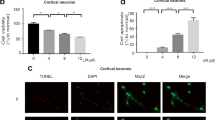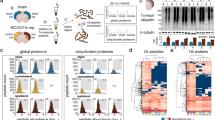Abstract
The effect of transient cerebral ischemia on phosphorylation of the microtubule-associated protein (MAP) τ was investigated using the rat four-vessel occlusion model. Phosphorylation of τ is proposed to regulate its binding to microtubules, influencing the dynamics of microtubule assembly necessary for axonal growth and neurite plasticity. In this study, τ was rapidly dephosphorylated during ischemia in the hippocampus, neocortex, and striatum. Dephosphorylation of τ was observed within 5 min of occlusion and increased after 15 min in all three brain regions, regardless of their relative vulnerability to the insult. Thus, dephosphorylation of τ is an early marker of ischemia and precedes the occlusion time required to cause extensive neuronal cell death in this model. On restoration of blood flow for a little as 15 min, τ was phosphorylated at a site(s) that causes a reduction in its electrophoretic mobility. The dephosphorylation/phosphorylation of τ may alter its distribution between axon and cell body, and affect its susceptibility to proteolysis. These changes would be expected to influence microtubule stability, possibly contributing to disruption of axonal transport, but also allowing neurite remodeling in a regenerative response.
Similar content being viewed by others
Abbreviations
- MAP:
-
microtubule-associated protein
- AD:
-
Alzheimer disease
- PHF:
-
paired helical filaments
- SDS-PAGE:
-
sodium dodecyl sulfate-polyacrylamide gel electrophoresis
- BSA:
-
bovine serum albumin
- TBS:
-
Tris-buffered saline
- MAb:
-
monoclonal antibody
- RSCIM:
-
rabbit spinal cord ischemia model
References
Biernat J., Mandelkow E.-M., Schröter C., Lichtenberg-Kraag B., Steiner B., Berling B., et al. (1992) The switch of tau protein to an Alzheimer-like state includes the phosphorylation of two serine-proline motifs upstream of the microtubule binding region.EMBO J. 11, 1593–1597.
Biernat J., Gustke N., Drewes G., Mandelkow E.-M., and Mandelkow E. (1993) Phosphorylation of Ser262 strongly reduces binding of tau to microtubules: distinction between PHF-like immunoreactivity and microtubule binding.Neuron 11, 53–163.
Billingsley M. L. and Kincaid R. L. (1997) Regulated phosphorylation and dephosphorylation of tau protein: effects on microtubule interaction, intracellular trafficking and neurodegeneration.Biochem. J. 323, 577–591.
Binder L. I., Frankfurter A., and Rebhun L. I. (1985) The distribution of tau in the mammalian central nervous system.J. Cell Biol. 101, 1371–1378.
Bush M. L., Miyashiro J. S., and Ingram V. M. (1995) Activation of a neurofilament kinase, a tau kinase, and a tau phosphatase by decreased ATP levels in nerve growth factordifferentiated PC-12 cells.Proc. Natl. Acad. Sci. USA 92, 1861–1865.
Chiang M. F., Liu W.-K., and Yen S.-H. (1993) Reversible heat stress-related loss of phosphorylated Alzheimer-type epitopes in tau proteins of human neuroblastoma cells.J. Neurosci. 13, 4854–4860.
Choi D. W. (1990) The role of glutamate neurotoxicity in hypoxic-ischemic neuronal death.Annu. Rev. Neurosci. 13, 171–182.
Davis D. R., Brion J.-P., Couck A.-M., Gallo J.-M., Hanger D. P., Ladhani K., et al. (1995) The phosphorylation state of the microtubule-associated protein tau as affected by glutamate, colchicine and ß-amyloid in primary rat cortical neuronal cultures.Biochem. J. 309, 941–949.
Davis D. R., Anderton B. H., Brion J.-P., Reynolds C. H., and Hanger D. P. (1997) Oxidative stress induces dephosphorylation of τ in rat brain primary neuronal cultures.J. Neurochem. 68, 1590–1597.
Dewar D. and Dawson D. (1995) Tau protein is altered by focal cerebral ischaemia in the rat: an immunohistochemical and immunoblotting study.Brain Res. 684, 70–78.
Drechsel D. N., Hyman A. A., Cobb M. H., and Kirschner M. W. (1992) Modulation of the dynamic instability of tubulin assembly by the microtubule-associated protein tau.Mol. Biol. Cell. 3, 1141–1154.
Drewes G., Mandelkow E.-M., Baumann K., Goris J., Merlevede W., and Mandelkow E. (1993) Dephosphorylation of tau protein and Alzheimer paired helical filaments by calcineurin and phosphatase-2A.FEBS Lett. 336, 425–432.
Drewes G., Trinczek B., Illenberger S., Biernat J., Schmitt-Ulms G., Meyer H. E., et al. (1995) Microtubule-associated protein/microtubule affinity-regulating kinase (p110mark).J. Biol. Chem. 270, 7679–7688.
Drubin D., Kobayashi S., and Kirschner M. (1986) Association of tau protein with microtubules in living cells.Ann. NY Acad. Sci. 466, 257–268.
Fleming L. M. and Johnson G. V. W. (1995) Modulation of the phosphorylation state of tauin situ: the roles of calcium and cyclic AMP.Biochem. J. 309, 41–47.
Galloway P. G., Perry G., Kosik K. S., and Gambetti P. (1987) Hirano bodies contain tau protein.Brain Res. 403, 337–340.
Geddes J. W., Bondada V., and Keller J. N. (1994a) Effects of intrahippocampal colchicine administration of the levels and localization of microtubule-associated proteins, tau and MAP2.Brain Res. 633, 1–8.
Geddes J. W., Schwab C., Craddock S., Wilson J. L., and Pettigrew L. C. (1994b) Alterations in τ immunostaining in the rat hippocampus following transient cerebral ischemia.J. Cereb. Blood Flow Metab. 14, 554–564.
Goedert M. (1993) Tau protein and the neurofibrillary pathology of Alzheimer’s disease.Trends Neurol. Sci. 16, 460–465.
Goedert M., Cohen E. S., Jakes R., and Cohen P. (1992) p42 map kinase phosphorylation sites in microtubule-associated protein tau are dephosphorylated by protein phosphatase 2A.FEBS Lett. 312, 95–99.
Gong C.-X., Grundke-Iqbal I., Damuni Z., and Khalid I. (1994a) Dephosphorylation of microtubule-associated protein tau by protein phosphatase-1 and-2C and its implication in Alzheimer disease.FEBS Lett. 341, 94–98.
Gong C.-X., Singh T. J., Grundke-Iqbal I., and Iqbal K. (1994b) Alzheimer’s disease abnormally phosphorylated τ is dephosphorylated by protein phosphatase-2B (calcineurin).J. Neurochem. 62, 803–806.
Grundke-Iqbal I., Iqbal K., Tung Y., Quinlan M., Wisniewski H. M., and Binder L. I. (1986) Abnormal phosphorylation of the microtubule-associated protein tau in Alzheimer cytoskeletal pathology.Proc. Natl. Acad. Sci. USA 83, 4913–4917.
Hirokawa N. (1994) Microtubule organization and dynamics dependent on microtubuleassociated proteins.Curr. Opinion Cell Biol. 6, 74–81.
Hsu M. and Buzsáki G. (1993) Vulnerability of mossy fiber targets in the rat hippocampus to forebrain ischemia.J. Neurosci. 13, 3964–3979.
Kanai Y. and Hirokawa N. (1995) Sorting mechanisms of tau and MAP2 in neurons: Suppressed axonal transit of MAP2 and locally regulated microtubule binding.Neuron 14, 421–432.
Kitagawa K., Matsumoto M., Niinobe M., Mikoshiba K., Hata R., Ueda H., et al. (1989) Microtubule-associated protein 2 as a sensitive marker for cerebral ischemic damage-immunohistochemical investigation of dendritic damage.Neuroscience 31, 401–411.
Kosik K. S. and McConlogue L. (1994) Microtubule-associated protein function: Lessons from expression inSpodoptera frugiperda cells.Cell Motil. Cytoskel. 28, 195–198.
Kosik K. S., Orcchio L. D., Binder L., Trojanowski J. Q., Lee V. M., and Lee G. (1988) Epitopes that span the tau molecule are shared with paired helical filaments.Neuron 1, 817–825.
Kowall N. W. and Kosik K. S. (1987) Axonal disruption and aberrant localization of tau protein characterize the neuropil pathology of Alzheimer’s disease.Ann. Neurol. 22, 639–643.
Laemmli U. K. (1970) Cleavage of structural proteins during assembly of the head of bacteriophage T4.Nature 227, 680–685.
Lee G. (1990) Tau protein: an uptade on structure and function.Cell Motil. Cytoskel. 15, 199–203.
Lee K. S., Frank S., Vanderklish P., Arai A., and Lynch G. (1991) Inhibition of pro protects hippocampal neurons from ischemia.Proc. Natl. Acad. Sci. USA 88, 7233–7237.
Lindwall G. and Cole R. D. (1984) Phosphorylation affects the ability of tau protein to promote microtubule assembly.J. Biol. Chem. 259, 5301–5305.
Litersky J. M. and Johnson G. V. W. (1992) Phosphorylation by cAMP-dependent protein kinase inhibits the degradation of tau by calpain.J. Biol. Chem. 267, 1563–1568.
Lowry O. H., Rosebrough N. J., Farr A. L., and Randall R. J. (1951) Protein measurement with Folin phenol reagent.J. Biol. Chem. 193, 265–272.
Mandelkow E. and Mandelkow E. (1993) Tau as a marker for Alzheimer’s disease.Trends Biochem. Sci. 18, 480–483.
Matsuo E. S., Shin R., Billingsley M. L., Van de Voorde A., O’Connor M., Trojanowski J. Q., et al. (1994) Biopsy-derived adult human brain tau is phosphorylated at many of the same sites as Alzheimer’s disease paired helical filament tau.Neuron 13, 989–1002.
Mattson M. P. (1992) Effects of microtubule stabilization and destabilization on tau immunoreactivity in cultured hippocampal neurons.Brain Res. 582, 107–118.
Merrick S. E., Demoise D. C., and Lee V. M. (1996) Site-specific dephosphorylation of tau protein at Ser202/Thr205 in response to microtubule depolymerization in cultured human neurons involves protein phosphatase 2A.J. Biol. Chem. 271, 5589–5594.
Morishima-Kawashima M., Hasegawa M., Takio K., Suzuki M., Yoshida H., Watanabe A., et al. (1995) Hyperphosphorylation of tau in PHF.Neurobiol. Aging 16, 365–380.
Norman S. G. P. and Johnson G. V. W. (1994) Compromised mitochondrial function results in dephosphorylation of tau through a calcium-dependent process in rat brain cerebral cortical slices.Neurochem. Res. 19, 1151–1158.
Papasozomenos S. C. and Binder L. I. (1987) Phosphorylation determines two distinct species of tau in the central nervous system.Cell Motil. Cytoskel. 8, 210–226.
Papasozomenos S. C. and Su Y. (1991) Altered phosphorylation of τ protein in heat-shocked rats and patients with Alzheimer disease.Proc. Natl. Acad. Sci. USA 88, 4543–4547.
Papasozomenos S. C. and Su Y. (1995) Rapid dephosphorylation of τ in heat-shocked fetal rat cerebral explants: prevention and hyperphosphorylation by inhibitors of protein phosphatases PP1 and PP2A.J. Neurochem. 65, 396–406.
Pettigrew L. C., Holtz J. L., Craddock S. D., Minger S. L., Hall N., and Geddes J. W. (1996) Microtubular proteolysis in focal cerebral ischemia.J. Cereb. Blood Flow Metab. 16, 1189–1202.
Pulsinelli W. A. and Brierley J. B. (1979) A new model of bilateral hemispheric ischemia in the unanesthetized rat.Stroke 10, 267–272.
Pulsinelli W. A. and Buchan A. M. (1988) The four-vessel occlusion rat model: Method for complete occlusion of vertebral arteries and control of collateral circulation.Stroke 19, 913–914.
Pulsinelli W. A., Brierley J. B., and Plum F. (1982) Temporal profile of neuronal damage in a model of transient forebrain ischemia.Ann. Neurol. 11, 492–498.
Rothman S. M. and Olney J. W. (1986) Glutamate and the pathophysiology of hypoxic-ischemic brain damage.Ann. Neurol. 19, 105–111.
Shackelford D. A. and Nelson K. E. (1996) Changes in phosphorylation of τ during ischemia and reperfusion in the rabbit spinal cord.J. Neurochem. 66, 286–295.
Siesjö B. K. and Bengtsson F. (1989) Calcium fluxes, calcium antagonists, and calciumrelated pathology in brain ischemia, hypoglycemia, and spreading depression: A unifying hypothesis.J. Cereb. Blood Flow Metab. 9, 127–140.
Smith, M.-L., Auer R. N., and Siesjö B. K. (1984) The density and distribution of ischemic brain injury in the rat following 2–10 min of forebrain ischemia.Acta Neuropathol. 64, 319–332.
Szendrei G. I., Lee V. M., and Otvos L., Jr (1993) Recognition of the minimal epitope of monoclonal antibody tau-1 depends upon the presence of a phosphate group but not its location.J. Neurosci. Res. 34, 243–249.
Trojanowski J. Q. and Lee V. M. (1995) Phosphorylation of paired helical filament tau in Alzheimer’s disease neurofibrillary lesions: focusing on phosphatases.FASEB J. 9, 1570–1576.
Winer B. J. (1971)Statistical Principles in Experimental Design, 2nd ed. McGraw-Hill, New York.
Yamamoto H., Saitoh Y., Fukunaga K., Nishimura H., and Miyamoto E. (1988) Dephosphorylation of microtubule proteins by brain protein phosphatases 1 and 2A, and its effect on microtubule assembly.J. Neurochem. 50, 1614–1623.
Yanagihara T., Brengman J. W., and Mushynski W. E. (1990) Differential vulnerability of microtubule components in cerebral ischemia.Acta Neuropathol. 80, 499–505.
Author information
Authors and Affiliations
Corresponding author
Rights and permissions
About this article
Cite this article
Shackelford, D.A., Yeh, R.Y. Dephosphorylation of tau during transient forebrain ischemia in the rat. Molecular and Chemical Neuropathology 34, 103–120 (1998). https://doi.org/10.1007/BF02815073
Received:
Revised:
Accepted:
Issue Date:
DOI: https://doi.org/10.1007/BF02815073




